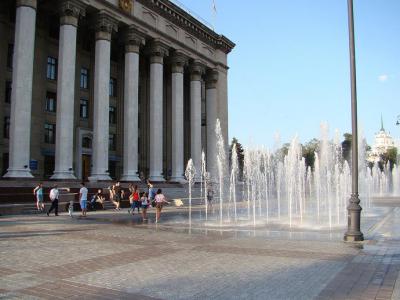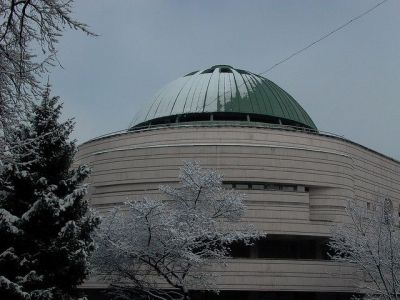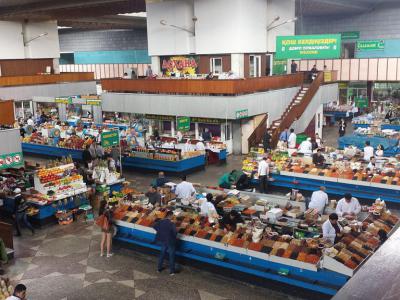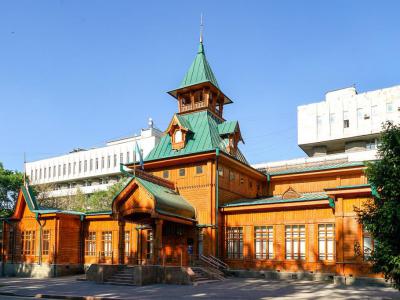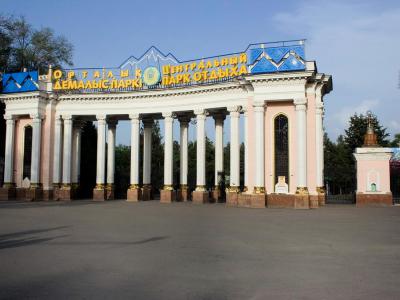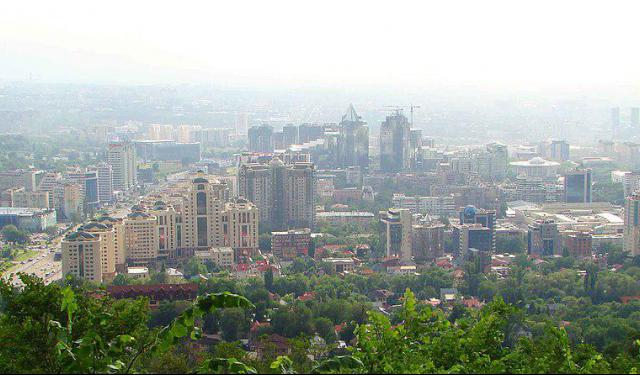
Almaty Introduction Walking Tour (Self Guided), Almaty
Nursultan Nazarbayev, the former (and the first) President of Kazakhstan, once remarked: "Almaty is the pearl of Kazakhstan, the most beautiful city in Central Asia." Indeed, the country's largest metropolis, Almaty is like a butterfly that has emerged from its cocoon, spreading its wings and soaring towards the sky at the foothills of the Tien Shan Mountains.
The name Almaty is rooted in the ancient settlement Almatau whose name translates as “Apple Mountain”. Derived from the Kazakh word "alma" for apple, it was reportedly due to the apple trees that once grew in abundance in the area.
The settlement emerged during the Bronze Age, circa 1000 BC, and eventually became an important center for trade and commerce, thanks to its location on the Silk Road. In the mid-19th century, the Russians established here a fort called Verniy (which means “Loyal”) that soon developed into a town named Almatinsk.
During the Soviet era and shortly after, Almaty served as the capital of Kazakhstan and developed into a modern industrial and cultural hub. Even after the country's capital moved to Astana, in 1997, Almaty remains an important city and popular tourist destination where "you can feel the heartbeat of Kazakhstan, hear the echoes of its past, and see the promise of its future."
The most notable local attractions include popular gathering spots like Astana Square and Panfilov Park. The latter is home to yet another prominent landmark, the Zenkov (or Ascension) Cathedral, a tsarist-era Russian Orthodox church. Also worthy of checking out are the Green Bazaar, a traditional market for fresh produce, and the pedestrianized Arbat thoroughfare lined with multiple shops, cafes, and restaurants.
Today's Almaty is a mix of ancient traditions and modern innovations coexisting harmoniously – “a city that inspires creativity and celebrates diversity, and where every street corner tells a different story." You can hear these stories and appreciate the cultural richness of Almaty yourself when out on a self-guided walk powered by the GPSmyCity app.
The name Almaty is rooted in the ancient settlement Almatau whose name translates as “Apple Mountain”. Derived from the Kazakh word "alma" for apple, it was reportedly due to the apple trees that once grew in abundance in the area.
The settlement emerged during the Bronze Age, circa 1000 BC, and eventually became an important center for trade and commerce, thanks to its location on the Silk Road. In the mid-19th century, the Russians established here a fort called Verniy (which means “Loyal”) that soon developed into a town named Almatinsk.
During the Soviet era and shortly after, Almaty served as the capital of Kazakhstan and developed into a modern industrial and cultural hub. Even after the country's capital moved to Astana, in 1997, Almaty remains an important city and popular tourist destination where "you can feel the heartbeat of Kazakhstan, hear the echoes of its past, and see the promise of its future."
The most notable local attractions include popular gathering spots like Astana Square and Panfilov Park. The latter is home to yet another prominent landmark, the Zenkov (or Ascension) Cathedral, a tsarist-era Russian Orthodox church. Also worthy of checking out are the Green Bazaar, a traditional market for fresh produce, and the pedestrianized Arbat thoroughfare lined with multiple shops, cafes, and restaurants.
Today's Almaty is a mix of ancient traditions and modern innovations coexisting harmoniously – “a city that inspires creativity and celebrates diversity, and where every street corner tells a different story." You can hear these stories and appreciate the cultural richness of Almaty yourself when out on a self-guided walk powered by the GPSmyCity app.
How it works: Download the app "GPSmyCity: Walks in 1K+ Cities" from Apple App Store or Google Play Store to your mobile phone or tablet. The app turns your mobile device into a personal tour guide and its built-in GPS navigation functions guide you from one tour stop to next. The app works offline, so no data plan is needed when traveling abroad.
Almaty Introduction Walking Tour Map
Guide Name: Almaty Introduction Walking Tour
Guide Location: Kazakhstan » Almaty (See other walking tours in Almaty)
Guide Type: Self-guided Walking Tour (Sightseeing)
# of Attractions: 8
Tour Duration: 2 Hour(s)
Travel Distance: 3.6 Km or 2.2 Miles
Author: JohnB
Sight(s) Featured in This Guide:
Guide Location: Kazakhstan » Almaty (See other walking tours in Almaty)
Guide Type: Self-guided Walking Tour (Sightseeing)
# of Attractions: 8
Tour Duration: 2 Hour(s)
Travel Distance: 3.6 Km or 2.2 Miles
Author: JohnB
Sight(s) Featured in This Guide:
- Astana Square
- Arasan Baths
- Arbat Shopping Street
- Green Bazaar
- Ascension Cathedral
- Panfilov Heroes Memorial Park
- Kazakh Museum of Folk Musical Instruments
- Gorky Park
1) Astana Square
Located in Almaty, Astana Square (also known as Old Square) is the second-largest city square in the country, surpassed only by Republic Square. The square serves as a venue for a variety of public events, including concerts and ceremonies. It is situated in front of the Kazakh-British Technical University and features the monument of Aliya Moldagulova and Manshuk Mametova (two of the most important heroes in World War II) while being positioned to the left of the Panfilov Street Promenade. Before 1991, the square was named after Vladimir Lenin and featured a statue of him at its center.
In 1921, the area was named Red Square and underwent major redevelopment under Soviet authorities. The Imperial-era buildings were demolished and replaced with new government buildings. The square was paved with stones for the first time in 1937, and the administrative building was constructed on the corner of Panfilov Street in 1955. The following year, a monument to Soviet statesman Vladimir Lenin was erected on the square to commemorate October Revolution Day. Additionally, a new government building for the Kazakh Republic was completed, which currently serves as the Kazakh-British Technical University Building.
In 1980, the opening of Brezhnev Square in the city led to the nickname "Old Square" for Astana Square. In 1987, the Alley of Busts memorial complex was established on the square in honor of the 70th anniversary of the October Revolution. The Lenin Monument was moved to a different location in 1997. Renaming of the square reflected the newly established capital of Kazakhstan, Astana. The reconstruction of Astana Square was completed in September 2017, resulting in the reduction of car lanes and the addition of bicycle paths, granite paving stones, and landscaping with sod and lavender beds. The staircase esplanade was also renewed and now features an open amphitheater and two illuminated dry fountains.
In 1921, the area was named Red Square and underwent major redevelopment under Soviet authorities. The Imperial-era buildings were demolished and replaced with new government buildings. The square was paved with stones for the first time in 1937, and the administrative building was constructed on the corner of Panfilov Street in 1955. The following year, a monument to Soviet statesman Vladimir Lenin was erected on the square to commemorate October Revolution Day. Additionally, a new government building for the Kazakh Republic was completed, which currently serves as the Kazakh-British Technical University Building.
In 1980, the opening of Brezhnev Square in the city led to the nickname "Old Square" for Astana Square. In 1987, the Alley of Busts memorial complex was established on the square in honor of the 70th anniversary of the October Revolution. The Lenin Monument was moved to a different location in 1997. Renaming of the square reflected the newly established capital of Kazakhstan, Astana. The reconstruction of Astana Square was completed in September 2017, resulting in the reduction of car lanes and the addition of bicycle paths, granite paving stones, and landscaping with sod and lavender beds. The staircase esplanade was also renewed and now features an open amphitheater and two illuminated dry fountains.
2) Arasan Baths
Arasan, which means "a warm source" in Kazakh, is a wellness complex located in Almaty. Before the October Revolution, two public baths existed in Verny (the previous name of Almaty) known as "The Titov Brothers' Trade National Baths" and "Zhilenkov's Bath," which were utilized by most of the city's residents.
The construction of Arasan Baths began in 1979 and was completed in 1982, replacing the earlier public baths at the same site on Gogol Street. The complex, situated in the city's "Golden Square," was designed to be architecturally unique and includes Russian, Finnish, and oriental-style baths, a hydrotherapy establishment, a shower pavilion, and a children's department.
After Kazakhstan gained independence, the complex remained under state ownership but was completely leased out. The entire complex was renovated in 2012, and in 2016, the health complex was reconstructed again, with major restoration work carried out while maintaining the building's unique oriental character.
The project was designed to accommodate up to 2.5 thousand visitors per day. The five-story frame building with brick walls contains functional and technical spaces, with a semicircular western building dominating the spatial composition and crowned by a ribbed dome. The complex includes 12 pavilions with six domes made of precast concrete. The interior features valuable stones, wood, ceramics, and plaster, while the building's facade is decorated with granite and marble. The health complex was built to withstand the seismic activity of Almaty.
The construction of Arasan Baths began in 1979 and was completed in 1982, replacing the earlier public baths at the same site on Gogol Street. The complex, situated in the city's "Golden Square," was designed to be architecturally unique and includes Russian, Finnish, and oriental-style baths, a hydrotherapy establishment, a shower pavilion, and a children's department.
After Kazakhstan gained independence, the complex remained under state ownership but was completely leased out. The entire complex was renovated in 2012, and in 2016, the health complex was reconstructed again, with major restoration work carried out while maintaining the building's unique oriental character.
The project was designed to accommodate up to 2.5 thousand visitors per day. The five-story frame building with brick walls contains functional and technical spaces, with a semicircular western building dominating the spatial composition and crowned by a ribbed dome. The complex includes 12 pavilions with six domes made of precast concrete. The interior features valuable stones, wood, ceramics, and plaster, while the building's facade is decorated with granite and marble. The health complex was built to withstand the seismic activity of Almaty.
3) Arbat Shopping Street
Arbat Street, also known as Zhybek Zholy Street, is a bustling shopping hub in Almaty. This pedestrian-friendly street spans from Abylaikhan Avenue to Furmanov Street and is best explored on foot. The area offers a diverse range of shopping options, including high-end branded stores such as Mango and Zara, as well as charming small shops.
TSUM Shop, a popular spot for locals to fulfill their daily needs, is a unique hybrid of a department store and a bazaar. As you stroll along the street, you'll also find a variety of cafes and restaurants, ranging from fine dining to local cuisine.
Adding to its charm, Arbat Street is adorned with fountains, live sculptures, and sculpture expositions. Local artists sell their masterpieces here, which make for great souvenirs. Street musicians and impromptu flash mobs also add to the lively atmosphere of the street.
Arbat Street was the first pedestrian zone in Almaty, created in the late 1980s, and it continues to be a vibrant hub of activity. In 2017, the zone underwent reconstruction and is now connected to Panfilov Street Promenade, featuring even more fountains. There are plans to extend the pedestrian area to Seyfullin Prospect in the future. Don't miss out on the lively and exciting atmosphere of Arbat Street!
TSUM Shop, a popular spot for locals to fulfill their daily needs, is a unique hybrid of a department store and a bazaar. As you stroll along the street, you'll also find a variety of cafes and restaurants, ranging from fine dining to local cuisine.
Adding to its charm, Arbat Street is adorned with fountains, live sculptures, and sculpture expositions. Local artists sell their masterpieces here, which make for great souvenirs. Street musicians and impromptu flash mobs also add to the lively atmosphere of the street.
Arbat Street was the first pedestrian zone in Almaty, created in the late 1980s, and it continues to be a vibrant hub of activity. In 2017, the zone underwent reconstruction and is now connected to Panfilov Street Promenade, featuring even more fountains. There are plans to extend the pedestrian area to Seyfullin Prospect in the future. Don't miss out on the lively and exciting atmosphere of Arbat Street!
4) Green Bazaar (must see)
The Green Bazaar (Kök Bazaar), located at the intersection of Zenkov and Jibek Joly streets in Almaty, has been an important trading hub since it opened in 1875. Visitors can find a variety of goods, including spices, prepared foods, produce, textiles, furniture, and antiques. Originally, the area served as a guest yard for traveling merchants and caravans.
The guest yard, which consisted of two pavilions along Torgovaya Street, was completed in 1875. The complex welcomed visitors from all over Central Asia and neighboring countries. It was a symbol of commercial and industrial prosperity and architectural and urban planning art. After the earthquake of 1887, it was reconstructed and renamed the Central Farm Market before becoming known as the Green Bazaar.
In the 1920s, large-scale trade in agricultural products, vegetables, and fruits resumed due to the emergence of collective farms. During World War II, the bazaar was the only place where goods were sold for money, but prices were high due to the war. In the 1970s, the wooden market was demolished and replaced with a covered building designed in the brutalism style.
In 2017, a new shopping pavilion was built on the site of container pavilions and open trade counters. The pavilion occupies an area of about 20,000 square meters and includes retail space and a two-level car parking lot for 400 cars. Since February 2021, "Social shops" have been selling socially significant food products at reduced prices. Today, the Green Bazaar remains a popular tourist attraction in Almaty.
The guest yard, which consisted of two pavilions along Torgovaya Street, was completed in 1875. The complex welcomed visitors from all over Central Asia and neighboring countries. It was a symbol of commercial and industrial prosperity and architectural and urban planning art. After the earthquake of 1887, it was reconstructed and renamed the Central Farm Market before becoming known as the Green Bazaar.
In the 1920s, large-scale trade in agricultural products, vegetables, and fruits resumed due to the emergence of collective farms. During World War II, the bazaar was the only place where goods were sold for money, but prices were high due to the war. In the 1970s, the wooden market was demolished and replaced with a covered building designed in the brutalism style.
In 2017, a new shopping pavilion was built on the site of container pavilions and open trade counters. The pavilion occupies an area of about 20,000 square meters and includes retail space and a two-level car parking lot for 400 cars. Since February 2021, "Social shops" have been selling socially significant food products at reduced prices. Today, the Green Bazaar remains a popular tourist attraction in Almaty.
5) Ascension Cathedral (must see)
The Ascension Cathedral, also known as the Zenkov Cathedral, is a wooden Russian Orthodox church situated in Panfilov Park, Almaty. Completed in 1907, the building stands at a height of 56 meters and is believed to be the second-tallest wooden structure in the world. Interestingly, the cathedral was constructed entirely without nails.
In the late 19th century, the first bishops of the Turkistan eparchy recognized the need for a Russian Orthodox Church in Almaty. On September 26, 1903, the bishop of Turkestan and Tashkent, Paisii, sanctified the church's foundation, and the construction process began between 1904 and 1907.
The belfry was added in 1906, and the cathedral managed to survive the 1911 earthquake with minimal damage, a feat that some attributed to divine intervention. There are rumors that the decision to avoid using nails was influenced by their role in the crucifixion of Jesus.
The interior of the cathedral was constructed in art workshops in Moscow and Kyiv, and the iconostasis was painted by artist N. Khludov. Following the Russian Revolution, the cathedral was repurposed as the Central State Museum of the Kazakh Soviet Socialist Republic, and from 1930 to 1940, it was utilized by significant public organizations. The belfry even housed the first radio transmitters in Almaty.
From 1973 to 1976, restoration efforts were undertaken, and the cathedral was handed back to the Russian Orthodox Church in May 1995. After further restoration work in 1997, it was reopened for religious services.
From July 2017 to October 2020, the cathedral underwent extensive reconstruction, and it is now open to the public, welcoming visitors and newcomers.
In the late 19th century, the first bishops of the Turkistan eparchy recognized the need for a Russian Orthodox Church in Almaty. On September 26, 1903, the bishop of Turkestan and Tashkent, Paisii, sanctified the church's foundation, and the construction process began between 1904 and 1907.
The belfry was added in 1906, and the cathedral managed to survive the 1911 earthquake with minimal damage, a feat that some attributed to divine intervention. There are rumors that the decision to avoid using nails was influenced by their role in the crucifixion of Jesus.
The interior of the cathedral was constructed in art workshops in Moscow and Kyiv, and the iconostasis was painted by artist N. Khludov. Following the Russian Revolution, the cathedral was repurposed as the Central State Museum of the Kazakh Soviet Socialist Republic, and from 1930 to 1940, it was utilized by significant public organizations. The belfry even housed the first radio transmitters in Almaty.
From 1973 to 1976, restoration efforts were undertaken, and the cathedral was handed back to the Russian Orthodox Church in May 1995. After further restoration work in 1997, it was reopened for religious services.
From July 2017 to October 2020, the cathedral underwent extensive reconstruction, and it is now open to the public, welcoming visitors and newcomers.
6) Panfilov Heroes Memorial Park (must see)
The urban park situated in east-central Almaty surrounding the Ascension Cathedral is known as the Park of 28 Panfilov Guardsmen. It was named in honor of the Panfilov heroes, a group of 28 soldiers from an Infantry unit who lost their lives while defending Moscow against the German invasion during the Second World War. The group was named after Ivan Panfilov, the General who commanded the 316th division. The park features a giant black monument of soldiers from all 15 Soviet republics and an eternal flame commemorating the fall of World War II.
The park was established in the 1870s in the place of a village cemetery that was destroyed in 1921. It had several different names before being renamed in 1942 in honor of the Panfilov soldiers. The park contains several historical buildings dating back to the early and mid-20th century, including the Ascension Cathedral, which was constructed without a single nail, the Museum of Folk Musical Instruments, and the House of Officers.
Today, the Park of 28 Panfilov Guardsmen is a popular destination for both locals and tourists. Almaty citizens often lay flowers and wreaths at the park's base to honor those who died in World War II during Victory Day celebrations. In 1982, the park's Museum of Folk Instruments building, the Ascension Cathedral, and the Memorial of Glory were added to Kazakhstan's list of historical and cultural monuments of republican significance.
The park was established in the 1870s in the place of a village cemetery that was destroyed in 1921. It had several different names before being renamed in 1942 in honor of the Panfilov soldiers. The park contains several historical buildings dating back to the early and mid-20th century, including the Ascension Cathedral, which was constructed without a single nail, the Museum of Folk Musical Instruments, and the House of Officers.
Today, the Park of 28 Panfilov Guardsmen is a popular destination for both locals and tourists. Almaty citizens often lay flowers and wreaths at the park's base to honor those who died in World War II during Victory Day celebrations. In 1982, the park's Museum of Folk Instruments building, the Ascension Cathedral, and the Memorial of Glory were added to Kazakhstan's list of historical and cultural monuments of republican significance.
7) Kazakh Museum of Folk Musical Instruments
The Kazakh Museum of Folk Musical Instruments, situated in Almaty's Panfilov Park, is a surviving relic from Verny City (Almaty). Constructed in 1908 alongside the Ascension Cathedral, the wooden tower served as a venue for ceremonies and state receptions hosted by the military leadership of the Turkestan governor-generalship. After the Soviet Union's establishment, the structure served as the House of Officers until its transformation into a musical instruments museum in 1980, named after the Great Kazakh musician Ykylas, who advocated for folk culture's preservation and various national instruments.
The rectangular building with carved wooden platbands and a triaxial space-planning solution has survived several reconstructions. The entrance is marked by a high, keel-shaped porch supported by carved pillars, and the upper level features small square and keeled windows. During the 1979 renovation, Kazakh national patterns were added to the wooden carvings. In front of the tower stands a sculpture of the Kazakh bow instrument.
The museum's collection contains over 1000 musical instruments, including 60 types of Kazakh national instruments, with some dating back to the 17th century. Several halls showcase the history of the musical instruments of Turkic peoples, percussion instruments, winning instruments of the first Republican Instrument-Making Contest, and instruments from Turkic-speaking and world countries.
The rectangular building with carved wooden platbands and a triaxial space-planning solution has survived several reconstructions. The entrance is marked by a high, keel-shaped porch supported by carved pillars, and the upper level features small square and keeled windows. During the 1979 renovation, Kazakh national patterns were added to the wooden carvings. In front of the tower stands a sculpture of the Kazakh bow instrument.
The museum's collection contains over 1000 musical instruments, including 60 types of Kazakh national instruments, with some dating back to the 17th century. Several halls showcase the history of the musical instruments of Turkic peoples, percussion instruments, winning instruments of the first Republican Instrument-Making Contest, and instruments from Turkic-speaking and world countries.
8) Gorky Park (must see)
Gorky Park, also referred to as Central Park, is an urban park located in the Medeu District of Almaty. It covers an area of 42 hectares and features different types of trees such as elm, oak, aspen, maple, pine, spruce, poplar, and birch, as well as artificial water reservoirs and various attractions such as a water park, movie theater, sports complex, cultural venues, public catering establishments, and children's attractions, including a children's railway and an aqua park.
The park's history dates back to 1856 when it was established as a public garden for the officers of the Vernensky garrison. The park was developed by scientist-gardener G. Krishtopenko, who planted deciduous and coniferous trees, including species characteristic of Central Russia. The park underwent several developments over the years, including opening a horticulture school, a zoo, and the construction of recreational centers, dance floors, and gazebos.
During the 1905 Russian Revolution and the Russian Civil War in 1918, the park served as a venue for political gatherings and a defensive line for the Red Army. In 1934, the park underwent reconstruction and was equipped with recreation centers for workers and unique irrigation and ditch systems. The park was renamed Gorky Park of Culture and Rest in 1935 and received a monument to Maxim Gorky in 1940.
In 1997, a contract was signed for the trust management of the park, followed by its privatization in 2004. The park underwent a reconstruction in 2018, resulting in the installation of various recreational facilities at the parking site, including children's and street workout playgrounds, basketball and football fields, a roller drome, and a skate track. Additionally, modern lighting and benches were installed throughout the park's premises, while the idle fountains and the amphitheater were updated.
The park's history dates back to 1856 when it was established as a public garden for the officers of the Vernensky garrison. The park was developed by scientist-gardener G. Krishtopenko, who planted deciduous and coniferous trees, including species characteristic of Central Russia. The park underwent several developments over the years, including opening a horticulture school, a zoo, and the construction of recreational centers, dance floors, and gazebos.
During the 1905 Russian Revolution and the Russian Civil War in 1918, the park served as a venue for political gatherings and a defensive line for the Red Army. In 1934, the park underwent reconstruction and was equipped with recreation centers for workers and unique irrigation and ditch systems. The park was renamed Gorky Park of Culture and Rest in 1935 and received a monument to Maxim Gorky in 1940.
In 1997, a contract was signed for the trust management of the park, followed by its privatization in 2004. The park underwent a reconstruction in 2018, resulting in the installation of various recreational facilities at the parking site, including children's and street workout playgrounds, basketball and football fields, a roller drome, and a skate track. Additionally, modern lighting and benches were installed throughout the park's premises, while the idle fountains and the amphitheater were updated.
The Most Popular Cities
/ view all
